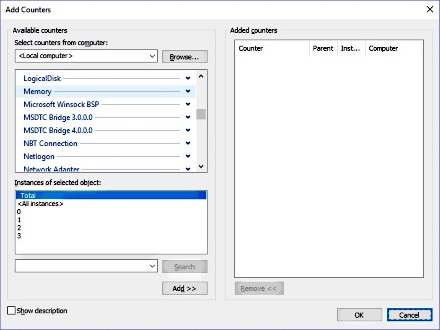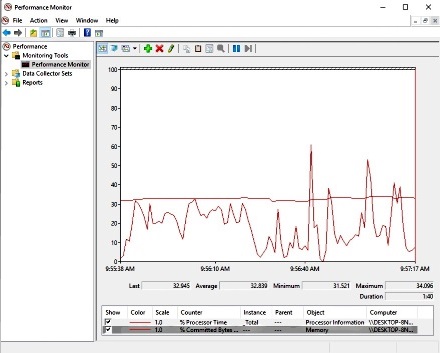Performance Monitor is a visual tool that system administrators can use to examine how various parameters of a Windows system are performing. To access Performance Monitor:
1. In Control Panel, click on the Administrative Tools icon.
2. In the Administrative Tools windows that appears, double-click on the Performance Monitor icon.
3. In the left-panel of the Performance Monitor window, click on Monitoring Tools | Performance Monitor

By default Performance Monitor shows a running graph of the percent of Processor time being utilized. Click on the green + icon at the top of the chart window to open a dialog box with a list of other monitors you can add to the chart. One interesting thing to monitor is Memory. In the list, scroll to Memory and click on the down arrow next to it, this expands Memory into a list of memory properties, called counters that you can display. Highlight % Committed Bytes In Use and click on the [Add>>] button. Then click on the [OK] button.

Other counters you might find interesting are:
• Physical Disk | % Disk Time: Displays the percentage of the hard drive's time spent performing read and / or write requests.
• Network Interface | Bytes Total/sec: Displays how many bytes are sent and received over a particular network interface.
To remove a counter's trace from the display, in the list of counters at the bottom of Performance Monitor, uncheck the counter you wish to remove. To start monitoring that counter again, just reset the check. To remove the counters name from the list, highlight the name and click on the red x icon at the top of the chart window.
More Windows Troubleshooting Articles:
• Stop Windows Freezing and System Lockups
• Fix 0x80070035 Error on a Windows PC
• Troubleshooting a Dead Computer
• Quick and Easy Guide to Reinstall the Video Driver
• Hard Drive Does Not Boot
• Can't Boot From CD or DVD Drive
• How to Troubleshoot Your Computer's Mouse
• System Restore: The Big Undo
• No Computer Sound
• How to Fix RpcRtRemote.dll Errors

